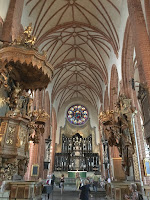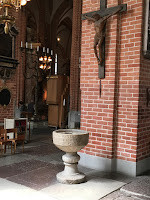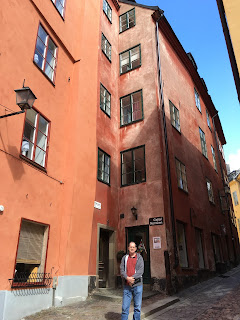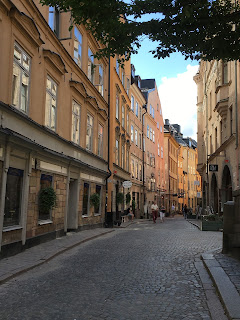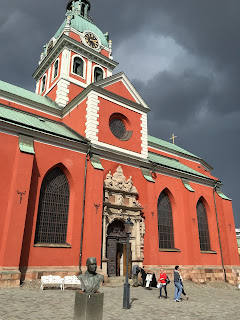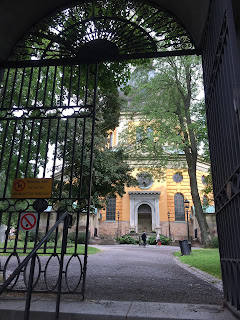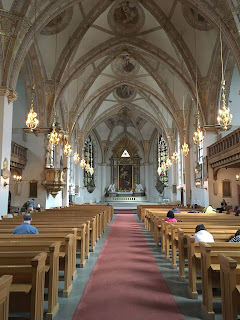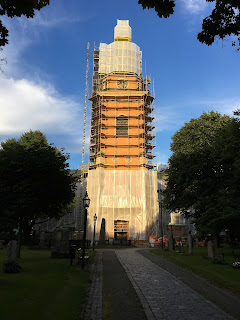Although three of my four grandparents were Irish, I feel like I've invested most of my efforts over the past few years on the history of my Swedish grandfather, Fred Johnson. Primarily that's because there is so much documentation available from Sweden, records that extend back to the late 1600s. In these documents you not only see the names of people, lots of names (!), but also the names of places: church parishes, towns, cities, and farms where relatives lived and worked. In the process I've also been able to link up over the Internet with Swedish relatives with similar interests. These next blog posts, then, could be subtitled: “What I did during summer vacation” because we decided to throw caution to the wind and to travel to Sweden. I had two goals, neither of which was to do any family history research. Rather, I wanted to see and visit the places I'd been reading about, to convert words on pages into reality. The second goal was to meet at least some of the contacts I'd been so fortunate to make. So, Luciana and I took the plunge: our itinerary was to visit Stockholm for one week, then drive on about an hour west for a week in the city of Västerås, and finally travel another three hours west to explore the small towns in the county of Värmland. Since this blog is supposed to be focused on family history, I´ll do my best to not turn this into a travelog.
Stockholm
The earliest records that I've found so far for a family member living in Stockholm is for Axel Westerlund (1784-1840). There is a household record that shows him and his family living in Europa Quarter in 1819, and his occupation is ”Police Gewaldigern” which, I think, is translated as a bailiff. I'm not sure exactly what that job entailed in Stockholm in the early 1800's, but bailiffs certainly had a bad name in earlier times. They were the ones that would wring taxes out of the populace for the government.
A map of modern Stockholm showing churches that figure in family history (click on the image to open in a new window at full size). 1) Stockholm Cathedral (Storkyrkan); 2) Sankt Jakob; 3) Hedvig Eleonora; 4) Sankt Johannes; 5) Adolf Fredrik; 6) Sankta Klara; 7) Maria Magdalena; 8) Katarina.
There is a record of the baptism of Axel's daughter, Mathilda Eleonora, in 1815 in the cathedral in Gamla Stan. The church is also known as Storkyrkan (the big church), Domkyrkan, or Sankt Nikolai (number 1 in the lowermost red dot on the map). A little geography is in order. The oldest records for the city of Stockholm date from the mid 13th Century. Today the city sprawls over 14 islands as well as the mainland, but it originated on a small central island. That part of the city today is known as Gamla Stan, the old city. Here's a link to an interesting website where you can see maps of Stockholm at different periods in history. It opens with a map of Stockholm today (that's idag in Swedish), but if you click on the work Idag a drop-down menu will appear from which you can see the city in earlier times. Try selecting 1885: that's the most useful one I've found when looking for old addresses. Many of the classic images of Stockholm are pictures of the medieval buildings of Gamla Stan. And standing high above the houses are a couple of church towers: one is the cathedral, and the other is the German Lutheran Church, Saint Gertrude. Gamla Stan is not only home of the main cathedral, but also the Royal Palace and the Nobel Museum. Although the streets have names and the street-level entrances to buildings have numbers, the area is organized into quarters, and in this part of the city the quarters are basically the individual buildings. Outside of the old city, quarters are typically made up of a number of buildings, and street addresses there become more useful. The quarters in Gamla Stan are almost all named after mythological characters: Achilles, Cepheus, Cybele, etc. On that 1885 map I mentioned, the names of the quarters are written in red letters. Europa Quarter, where the Westerlund family is first recorded, is a sprawling area that directly faces the palace to the north and Storkyrkan right next to the Palace. Axel later moved farther south to the quarter of Cupido.
Stockholm cathedral inside and out. In the second row is the famous sculpture of Saint George (in Swedish, Sankt Göran) slaying the dragon. The statue was consecrated in 1489, and is made of wood and moose antler. It commemorates the victory of the Swedes over the invading Danes at the battle of Brunkeberg in 1471. St. George represents Sten Sture the Elder (the guide said that the sword is the actual one that he wielded in the battle). Off to the side is a small statue of a princess, Sweden, being saved from Christian I of Denmark. At the lower right a picture of the baptismal font, very likely the same one used for the baptism of Axel Westerlund's daughter Mathilda Eleonora. Streets of Gamla Stan. The upper two pictures are buildings where Axel Westerlund lived in the early 1880s: on the left is Europa Quarter and on the right is Cupido Quarter.In 1815 Axel married Catharina Ulrika Hempel in the church of Sankta Klara (#6 in green on the map). Klara is just to the north and a touch west of Gamla Stan. Quite a few other churches in the area figure in family history. I've labelled those on the map. The most prominent of these were Hedvig Eleonora (#3 in red) in Östermalm; Adolf Fredrik (#5 green) and Klara in Norrmalm; and Maria Magdalena (#7 blue) and and Katarina (#8 blue) in Södermalm. The map is a little deceiving: from our hotel in Gamla Stan you can easily walk to all of these, although I wouldn't want to try to get to all of them in a single day!
Families, and it seems particularly families led by widows, moved around quite a bit in the city. One reason for this might be that they simply went where the jobs were. In those pre-industrial times, being a servant was one of the few jobs available to widows with no near relatives. I can imagine lots of reasons for a widow to move from job to job, and house to house, from one year to the next. In the household records for these women their title would be simply ”widow,” while a man's title would generally tell what his occupation was. So for now, I have no facts, only speculation.
Churches of Stockholm. Left: S:t Jakob Church, with bust of famous Swedish operatic tenor Jussi Björling. Right: Hedvig Eleonora Church in Östermalm. Churches of Stockholm. Left: S:t Johannes Church. Right: Adolf Fredrik Church. The assassinatd Swedish Prime Minister, Olof Palme, is buried in the churchyard. Churches of Stockholm. Left: Interior of S:ta Klara Church in Norrmalm. Right: Maria Magdalena Church in Södermalm, entirely closed for renovation. Churches of Stockholm: Interior of Katarina Church in Södermalm.One other place to note, although we didn't go there: just below the word “Stockholm” on the map is an island called Långholmen. This island used to have a prison on it, and it was here that Axel's second son, Frans Daniel, died as a prisoner in 1881. I hope to explore that story in more detail soon.


